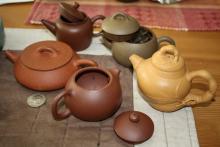Like many Asian tea-related subjects, Yixing ware is often misrepresented in the budding Western tea-drinking world. The general party line regarding Yixing tea ware is this: Yixing clay and pots originate from Yixing, a city in China’s Jiangsu province, where the clay is said to be remarkably pure and unlike any other clay in the world. Most Yixing clay pots are unglazed, allowing the porous clay to interact with the tea, improving the tea’s flavor. Because the pots are unglazed, they absorb some of the tea that’s brewed inside and will eventually build up a patina of tea residue inside. Because of this, a Yixing pot should be dedicated to one type of tea so the patina doesn’t interfere with another tea type’s flavor.
Like much information about Chinese tea traditions, this description has been repeated so many times that it’s taken as gospel truth. In reality, it’s a mixture of fact and marketing and people truly interested in Yixing ware eventually learn the full truth the hard (and expensive) way. Here’s a bit of emendation: Yixing clay is famous and possesses the characteristics described above. However, over time the Yixing clay mines’ output has dwindled and many Yixing pots are cheaply made from (at best) clay from other locations in China or (at worst) inferior industrially-dyed liquid clay that is hosed into molds. Yixing tea pots areunglazed and willaccumulate patina, but in reality the dangers of patina “interfering” with or greatly enhancing the flavor of a brew are pretty low. In my experience, the greatest benefit of authentic Yixing pots is that the different clay types affect tea differently, so certain clay types are better-suited to certain types of teas than they are to others—whether or not patina is affecting the tea’s flavor is secondary to how the clay affects the tea, which will usually be more pronounced (especially since patina takes years of repeated use to significantly build up). For example, porous clay often draws out intense flavors and softens the mouth feel of tea, so these types of clay are usually used with heavily roasted tea in order to mellow its flavor.
Traditionally, Yixing tea pots are most often used to brew oolong and pu-erh teas, but in reality some of the clay types will benefit green, black and white tea brewing, too—it just depends on whether or not the clay type performs well with the tea. Finally, because of their small size, most Yixing tea pots are best-suited to what’s known as gong fubrewing—a traditional Chinese tea preparation method that uses a high leaf-to-water ratio to steep a tea repeatedly using very short infusion times, often resulting in a tea session that reveals a tea’s many different characteristics a little bit at a time, developing with each steeping.
In part two of this ongoing series, I’ll discuss the somewhat confusing process of purchasing a quality Yixing tea pot.
